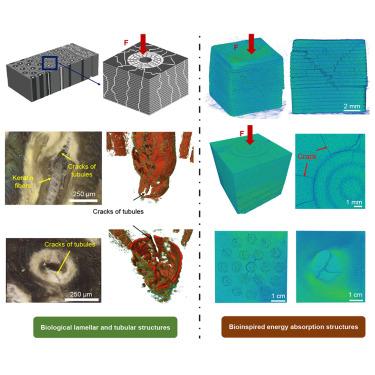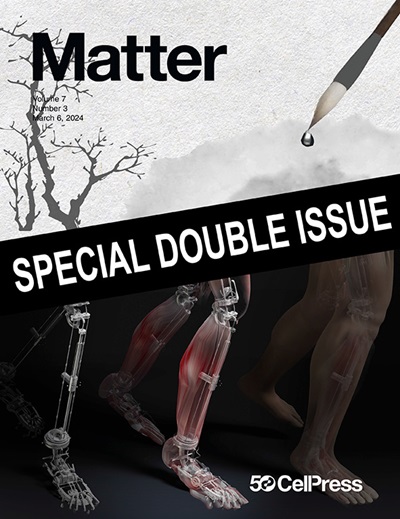Energy absorption strategy in biological and bioinspired tubular and lamellar structures
IF 17.3
1区 材料科学
Q1 MATERIALS SCIENCE, MULTIDISCIPLINARY
引用次数: 0
Abstract
Energy absorption capability is critical in biological and engineering materials, particularly when subjected to extreme compressive and impact loading. In the current work, we demonstrate how natural biological materials, like horns and hooves, control crack generation and propagation through lamellar and tubular structural designs. Inspired by these biological tissues, lamellar and tubular structures were fabricated via multi-material three-dimensional (3D) printing. The resulting bioinspired structures exhibit an impressive energy absorption density of ∼18.75 kJ kg−1, comparable to the performance of metal foams and bioinspired honeycomb structures. Introducing soft-hard interfaces in lamellar and tubules notably enhances impact energy absorption by approximately 167% compared to solid structures printed with a single material. The bioinspired structures maintain structural integrity even under high-strain-rate impacts of around 2,000 s−1, showcasing resistance to deformation and catastrophic failure. This bioinspired approach allows for a combined energy absorption capability in quasi-static compression and high-strain-rate impact scenarios.


生物和生物启发管状和片状结构的能量吸收策略
能量吸收能力对于生物和工程材料至关重要,尤其是在承受极端压缩和冲击载荷时。在目前的工作中,我们展示了天然生物材料(如角和蹄)如何通过片状和管状结构设计来控制裂纹的产生和传播。受这些生物组织的启发,我们通过多材料三维(3D)打印技术制造了片状和管状结构。由此产生的生物启发结构的能量吸收密度达到了惊人的 18.75 kJ kg-1,与金属泡沫和生物启发蜂窝结构的性能不相上下。与使用单一材料打印的固体结构相比,在片状和管状结构中引入软硬界面可显著提高冲击能量吸收率约 167%。生物启发结构即使在 2,000 s-1 左右的高应变速率冲击下也能保持结构完整性,从而展示出抗变形和抗灾难性破坏的能力。这种生物启发方法可在准静态压缩和高应变速率冲击情况下实现综合能量吸收能力。
本文章由计算机程序翻译,如有差异,请以英文原文为准。
求助全文
约1分钟内获得全文
求助全文
来源期刊

Matter
MATERIALS SCIENCE, MULTIDISCIPLINARY-
CiteScore
26.30
自引率
2.60%
发文量
367
期刊介绍:
Matter, a monthly journal affiliated with Cell, spans the broad field of materials science from nano to macro levels,covering fundamentals to applications. Embracing groundbreaking technologies,it includes full-length research articles,reviews, perspectives,previews, opinions, personnel stories, and general editorial content.
Matter aims to be the primary resource for researchers in academia and industry, inspiring the next generation of materials scientists.
 求助内容:
求助内容: 应助结果提醒方式:
应助结果提醒方式:


